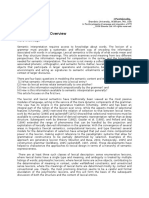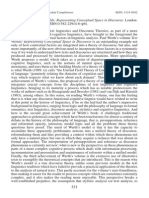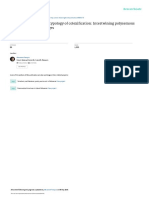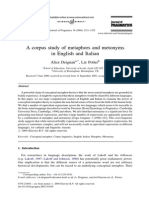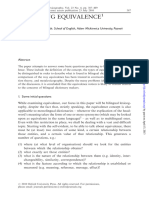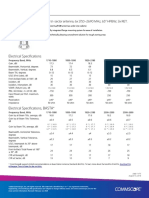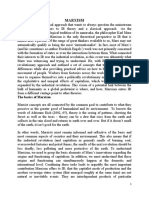Dancygier Sweetser Figurative Language
Uploaded by
LizaDancygier Sweetser Figurative Language
Uploaded by
LizaSee discussions, stats, and author profiles for this publication at: https://www.researchgate.
net/publication/284273591
Barbara Dancygier and Eve Sweetser, Figurative Language (review)
Article in English Text Construction · December 2015
DOI: 10.1075/etc.8.2.07rim
CITATIONS READS
2 3,925
1 author:
Sebastian Rimehaug
Villanova University
2 PUBLICATIONS 7 CITATIONS
SEE PROFILE
All content following this page was uploaded by Sebastian Rimehaug on 09 November 2018.
The user has requested enhancement of the downloaded file.
Note: This is an earlier draft, not the final version published in English Text Construction 8(2).
Barbara Dancygier and Eve Sweetser, Figurative Language (Cambridge Textbooks in
Linguistics). 2014. Cambridge: Cambridge University Press. ISBN 978-0-521-18473-1. 242 pp.
Reviewed by Sebastian Rimehaug (Case Western Reserve University)
From the departments that teach it to journals that publish it, cognitive linguistics is not just
for linguists anymore. Though cognitive linguists themselves have been making forays into areas
like literary studies (Turner 1991), rhetoric (Johnson 1987), and political discourse (Lakoff 2002
[1996]) from the beginning, scholars native to these and other fields are increasingly adopting
methodologies from cognitive linguistics in turn. With the backgrounds of scholars interested in
the relationship between language and the mind growing more and more diverse, so grows the
challenge of producing reference texts relevant to the needs of everyone involved. For long-time
collaborators Barbara Dancygier and Eve Sweetser (hereafter D&S), who have written together
and separately on topics as diverse as poetry, narrative discourse, metaphor, mental spaces, and
construction grammar, this is a challenge they have long been sensitive to. Their latest
collaboration, Figurative Language (2014), proves no exception.
Part of the Cambridge Textbooks in Linguistics series, the book reviews the cognitive
linguistic study of figurative language. Though readers interested in a more broadly historical
approach to linguistics and figurativity may find the title misleading, those interested in learning
the fundamental concepts in cognitive linguistics and the ways these concepts interact in
figurative language will find surprising succinctness and accessibility in its handling of a broad
array of complex concepts. As outlined in Chapter 1, the first half of the book discusses
metaphor (Ch. 2 & 3), blending (Ch. 4), and metonymy (Ch. 5) as the primary mappings that
prompt non-literal links between concepts. The remainder of the book focuses more pointedly on
the major findings from some of those researchers who study figurative language as a mapping,
devoting a chapter each to grammatical constructions (Ch. 6), crosslinguistic comparison (Ch. 7),
and extended discourse events (Ch. 8). The authors’ main argument is that figurative language is
not mere decoration and not limited to specialized, artistic spheres of use, but persists in the
everyday as an integral function of language as a whole. In other words, the act of saying (or
writing, drawing, or performing) one thing to mean another betrays pervasive patterns in
language and thought that are in turn ripe for empirical study. Many will recognize this view as a
basic tenet of conceptual metaphor theory, which the book’s structure does give preferential
treatment, but Dancygier and Sweetser likewise leave ample space in the discussion for other
areas of linguistic analysis, such as polysemy, blending, and construction grammar. This
approach sets the book apart from Croft and Cruse’s (2006) earlier entry in the Cambridge series,
Cognitive Linguistics, whose chapter on figurative language treats it as a somewhat separate
affair, and mostly limited to metaphor and metonymy.
Ch. 2 introduces the standard view of metaphor from conceptual metaphor theory, which
defines metaphors not as particular utterances, but as conceptual mappings between source and
target domains. An example of such a mapping includes the ARGUMENT IS WAR metaphor, in
which a verbal disagreement (i.e. the target ___domain of Argument) is construed through the
conceptual structure of a physical conflict between combatants (i.e. the source ___domain of War),
producing utterances like “He viciously attacked my views” (Dancygier and Sweetser 2014: 14).
The authors expand their discussion of source-target mappings by reviewing some of the
theoretical concepts that serve to organize the role of preexisting knowledge, principle of which
are frames, image schemas, primary scenes, and Primary Metaphors. Throughout the chapter as
well as the rest of the book, D&S anticipate and respond to possible misconceptions and areas of
difficulty, something scholars new to the field will appreciate. Some of these include the
difference between domains, frames, and scripts; the asymmetry between source and target; and
whether entrenched forms that no longer seem metaphorical can still “count” as metaphors (they
can). Another important point throughout the book is that metaphor and other figurative language
can motivate polysemy and meaning change, such as the Indo-European tendency for verbs of
seeing to take on connotations of knowing, sometimes losing the original sense on the way
(Sweetser 1990). Ch. 3 continues by elaborating on metaphoric structure, that is, on what
motivates mappings between source and target domains, and the relationships between
mappings. The main point of this chapter is to illustrate that metaphors do not occur in a vacuum;
instead, metaphors that seem more elaborate are often combinations of more schematic ones. The
authors discuss the Location Event Structure Metaphor (ESM), “a mapping between States and
Locations, and Change or Action and Motion”, as highly productive of other metaphors, most
notably LIFE IS A JOURNEY (Dancygier and Sweetser 2014: 45). The inheritance of multiple
metaphors by one, more compositionally complex metaphor is constrained by what Lakoff
(1993) calls the Invariance hypothesis, which maintains that causal structure must be preserved
on either side of a mapping. For example, an utterance like building a theory has to refer to an
as-yet incomplete theory (since buildings cannot be complete while still being built).
Ch. 4 briefly introduces mental spaces and blending, two related models of meaning
construction that allow analysis “to be explicit about the shared structure which constrains a
mapping (p. 74).” Blending originates from Mental Spaces Theory (Fauconnier 1994 [1985]),
whose primary unit of analysis is the mental space. Spaces are “partial cognitive
representations”, more fleshed out but less comprehensive than frames (Dancygier and Sweetser
2014: 77). “Blend” refers to the emergent space produced by two (or more) input spaces in
combination. In presenting a typology of blending, D&S stick to the four main categories raised
in Fauconnier and Turner (2002): simplex, single-scope, mirror, and double-scope. Constituent
to a blend in Fauconnier and Turner’s model are at least two Input spaces, a Blend space, and
also a fourth Generic space, which is meant to contain the relevant generic structure that prompts
a mapping between inputs. D&S note that the key addition that blending makes to the study of
mappings is a greater scale of complexity. They also point out that metaphorical mappings are
the same things as single-scope blends, that is, blends that inherit their structure from only one of
the two input spaces (the Source). The more complex blending types are demonstrated by
modeling figurative passages from Joanthan Raban’s travel writings. This chapter goes into
noticeably less depth on blending than the chapters surrounding it with their respective topics;
most of the works cited are not directly related to blending theory and even the existence of
alternatives to Fauconnier and Turner’s four-space model, like the one popularized in Brandt and
Brandt (2005), goes unmentioned. One reason for this may be that the concept of blending,
unlike metaphor and metonymy, does not predate cognitive linguistics and therefore requires
more introduction. Nonetheless, the information covered here is sufficient for understanding the
examples of blending used elsewhere in the book.
Ch. 5 moves on to metonymy. The authors clarify that they do not intend to cover the entire
current discussion on metonymy but rather, much like the rest of the book, present a formulation
most amenable to further linguistic analysis. By this formulation, metonymy subdivides into
categorical metonymy and frame metonymy, which they propose as alternatives to literary
theory’s shaky and inconsistent opposition between metonymy and synecdoche. Categorical
metonymy involves a relationship between a category and subordinate subcategory, in which one
stands for another, as when Kleenex is used as a catchall for any brand of facial tissue. Frame
metonymy presents a similar relationship between parts of the same frame, e.g. the use of field
hand as a name for a worker (named for the part of the body most associated with performing
work). Though metonymy is less studied than metaphor, D&S provide evidence that is in fact
more pervasive a conceptual force, often playing a behind the scenes role in organizing
metaphors, blends, and polysemy. An example of metonymy organizing metaphor is in the
contrastive terms for political campaign strategies: grassroots campaign, which is a spontaneous
citizen movement, and to astroturf, to attempt at fabricating what resembles a grassroots
campaign, typically by corporate or political entities. In both of these, metonymy serves as a
shortcut to a metaphorical mapping. Grassroots singles out one element in an entire frame of
natural plant growth; AstroTurf, by comparison, is an unconvincing commercial facsimile.
Ch. 6 marks the point where the book moves away from defining primary mappings and
instead demonstrates how these mappings work “in the wild”. The longest chapter, its focus is on
grammatical constructions, which, the authors clarify, are not just combinatory instructions for
strings of words and their individual meanings, but can carry meaning on their own. It follows,
then, that constructions themselves can be figurative. After giving a brief and lucid introduction
to construction grammar, much of the chapter focuses on those constructions that seem most
prone to prompting metaphoric mappings, such as the copular BE-construction, the Attributive-
Adjective Construction, and Domain-Adjective Construction. One possible reason these
constructions have a proclivity for metaphor is that their grammatical asymmetry accommodates
Source-Target asymmetry. To elaborate, they all typically specify a pair of semantically
autonomous and semantically dependent syntactic positions, making them good for organizing
Source-Target relationships (Sullivan 2013). For example, the Domain-Adjective construction
specifies a semantically autonomous adjective, as in the example spiritual wealth. Here, spiritual
is referring to literal spirituality of which wealth metaphorically represents some certain element.
Compare this with the Attributive-Adjective construction, on the other hand, which specifies a
semantically dependent adjective, as in the example bloodstained wealth. In this example, it is
the property of being bloodstained that is metaphorical (or metonymic, depending on the severity
of the accusation) and descriptive of literal, probably monetary, wealth. Also of note is the
chapter’s lengthy discussion on simile, which corrects the conventional definition of simile as
simply a metaphor with the addition of like. Instead, similes are instances of the comparative
construction that prompt single- or limited-scope blends, partially through their grammatical
asymmetry (cf. the examples above).
Ch. 7 begins, perhaps later than it should have, with the authors situating cognitive
linguistics within the context of related fields, particularly in terms of stance on linguistic
universals. On the one hand stand anthropological and literary scholars, who have a long history
with metaphor but are reluctant to admit to the existence any universals regarding them, and on
the other, the formal linguists, who are committed to finding universals in language but do not
find metaphor relevant to the search. The authors hint that the key to productively understanding
the ways in which language and metaphor are universal is to identify the constraints on variation,
rather than to make an exhaustive search for the structures shared by all. With the exception of
perhaps the Primary Metaphor MORE IS UP, which is informed by primary scenes that are simply
inescapable by any human on Earth, what is left in the literature are near-universals, mappings
that are common to many languages, but with distinctive cultural flavors and some outright
exceptions. One extensively studied near-universal is the mapping of time onto relative motion in
space, which produces utterances like the English Wednesday’s meeting was moved ahead (using
a front-back axis) but also utterances in, for example, French and Chinese, that arrange events in
time vertical space. However, D&S also point out work by Núñez and Sweetser (2006), which
reveals that Aymara, although it also uses space to conceptualize time, has no expressions that
convey the events in time or the speaker experiencing them as moving. Stranger still,
conventional spatial expressions regarding the future locate it behind the speaker, while the past
is in front, possibly an indication that the Primary Metaphor KNOWING IS SEEING is uniquely
responsible for organizing Aymara metaphors of time. The chapter concludes with a brief
overview of figurative language research in ASL.
Chapter 8 moves beyond the focus on sentence-level expressions and demonstrates how
the tools explored in the preceding chapters can also be applied to the analysis of more extended
discourse events, like works of literature. The chapter also serves as a demonstration of the wide
array of genres that depend on figurative strategies for communication. Maintaining the rest of
the book’s balance of examples from metaphor, metonymy, and blending, the chapter plays
particular attention to the idea of construals carrying an implied viewpoint. The first section
provides original analyses of two narratives on illness and one on addiction, showing how
construal of the speaker viewpoint in relation to a metaphorical narrative can play an important
role in whether the narrative makes a more personal or social statement, in the degree of agency
represented on the part of the speaker, and even in identifying irony. Much of the proceeding
discussion in this chapter, which includes such genres as political oration, travel writing, and
poetry, demonstrates the complex and fluid nature of metaphor, metonymy, and blending, which
often act jointly in a single construal. This is an extremely useful observation for new readers, as
this overlap is often not apparent from textbook examples handpicked to demonstrate only one
process of construal at a time. The chapter concludes with some discussions on the role of
figurative language in expressing the hard-to-express in both scientific and religious discourse.
Non-linguist readers may very well find this chapter to be the most interesting but also the most
cursory. The authors maintain, however, that their intention is not to be comprehensive but to
highlight salient avenues of linguistic research.
A previously stated, what Figurative Language markedly does not offer is a full history
of the field of linguistics’ engagement with its subject. Absent are any references to past schools
of linguistics like the Russian Formalists or the Prague Circle, save for two brief mentions of
Jakobson, as well as more recent formulations that are likewise peripheral to cognitive
linguistics, like those found in Sperber and Wilson’s pragmatics-based theory of relevance or
Halliday’s observations of the metaphor-like behavior of grammar. Also omitted are mentions of
less compatible albeit limited and short-lived treatments of figurative expressions within
generative grammar (Gläser 1971). But where the book is lacking in erudition, it makes up for in
practicality. It would of course most appeal to linguists interested in performing research in
figurative language, but it also doubles as a comprehensive but relatively short introduction to
cognitive linguistics itself. For researchers, the book serves as a useful reference for starting new
projects, as the authors make sure to point out underexplored topics, and, occasionally, research
dead-ends. They also do not just cite other authors, but describe the work of relevant research
groups, such as Pragglejaz and MetaNet. For students and faculty who are new to cognitive
linguistics, Figurative Language would make a good first book on the topic, because of its lucid
style, engaging examples, and careful attention to common misconceptions.
References
Brandt, Line and Per Aage Brandt. 2005. Making sense of a blend: A cognitive-semiotic
approach to metaphor. Annual Review of Cognitive Linguistics, 3, 216–249.
Croft, William and D. Alan Cruse. 2006. Cognitive Linguistics (Cambridge Textbooks in
Linguistics). Cambridge: Cambridge University Press.
Fauconnier, Gilles. 1994 [1985]. Mental spaces: aspects of meaning construction in natural
language. 2nd edn. Cambridge: Cambridge University Press.
Fauconnier, Gilles and Mark Turner. 2002. The way we think. New York: Basic Books.
Gläser, Rosemarie. 1971. The application of Transformational Generative Grammar to the
analysis of similes and metaphors in modern English. Style 5, 265-283.
Johnson, Mark. 1987. The body in the mind: the bodily basis of meaning, imagination, and
reason. Chicago: University of Chicago Press.
Lakoff, Geroge. 1993. The contemporary theory of metaphor. In Metaphor and thought, Andrew
Ortony (ed.). 2nd edn. Cambridge: Cambridge University Press, 202-51.
Lakoff, George. 2002 [1996]. Moral politics: how liberals and conservative think. Chicago:
University of Chicago Press.
Núñez, Rafael E., and Eve Sweetser. 2006. With the future behind them: convergent evidence
from Aymara language and gesture in the crosslinguistic comparison of spatial construals
of time. Cognitive Science 30(3), 401-50.
Sullivan, Karen. 2013. Frames and constructions in metaphoric language. Amsterdam and
Philadelphia: John Benjamins.
Sweetser, Eve. 1990. From etymology to pragmatics. Cambridge: Cambridge University Press.
Turner, Mark. 1991. Reading minds: the study of English in the age of cognitive science.
Princeton, NJ: Princeton University Press.
View publication stats
You might also like
- J Pustejovsky Lexical Semantics Overview 1No ratings yetJ Pustejovsky Lexical Semantics Overview 111 pages
- PDF - of - Heat Pump Water Heater PresentationNo ratings yetPDF - of - Heat Pump Water Heater Presentation43 pages
- Dancy Gi Er Sweetser Figurative LanguageNo ratings yetDancy Gi Er Sweetser Figurative Language7 pages
- Revisiting Common Source and Target Domains in Conceptual Metaphors in a Sample OfNo ratings yetRevisiting Common Source and Target Domains in Conceptual Metaphors in a Sample Of13 pages
- Book Review: Pragmatics and Discourse: A Resource Book For StudentsNo ratings yetBook Review: Pragmatics and Discourse: A Resource Book For Students4 pages
- Analysis_of_the_Quranic_Text_Using_intertextualityNo ratings yetAnalysis_of_the_Quranic_Text_Using_intertextuality10 pages
- Worlds: Representing Conceptual Space in Discourse Is An Outstanding Example NotNo ratings yetWorlds: Representing Conceptual Space in Discourse Is An Outstanding Example Not6 pages
- From Text Grammar To Critical Discourse Analysis PDFNo ratings yetFrom Text Grammar To Critical Discourse Analysis PDF46 pages
- Lexico-Grammatical Alignment in Metaphor Construal: Cognitive Linguistics January 2019No ratings yetLexico-Grammatical Alignment in Metaphor Construal: Cognitive Linguistics January 201940 pages
- Text Linguistics The Subject and Evolution of Text LinguisticsNo ratings yetText Linguistics The Subject and Evolution of Text Linguistics5 pages
- Dancygier y Sweetser Figurative LanguageNo ratings yetDancygier y Sweetser Figurative Language10 pages
- Conceptual Metaphoric Account of IdiomsNo ratings yetConceptual Metaphoric Account of Idioms22 pages
- Jiang 2018 Kristina Boreus and Goran Bergstrom Eds Analyzing Text and Discourse Eight Approaches For The Social SciencesNo ratings yetJiang 2018 Kristina Boreus and Goran Bergstrom Eds Analyzing Text and Discourse Eight Approaches For The Social Sciences3 pages
- Hunston, S., & Su, H. (2019) - Patterns, Constructions, and Local Grammar A Case Study of Evaluation'. Applied Linguistics, 40 (4), 567-593.No ratings yetHunston, S., & Su, H. (2019) - Patterns, Constructions, and Local Grammar A Case Study of Evaluation'. Applied Linguistics, 40 (4), 567-593.27 pages
- Cameron y Deignan La Emergencia de La Metáfora en El DiscursoNo ratings yetCameron y Deignan La Emergencia de La Metáfora en El Discurso20 pages
- Jacques Moeschler and Anne Reboul, -- Musiol, Michel -- Pragmatics & Cognition, #2, 3, pages 386-394, 1995 -- John Benjamins Publishing Company (ISSN -- 10.1075_pc.3.2.15mus -- b4333304676f45e0e1860bd8135e48df -- Anna’s ArchiveNo ratings yetJacques Moeschler and Anne Reboul, -- Musiol, Michel -- Pragmatics & Cognition, #2, 3, pages 386-394, 1995 -- John Benjamins Publishing Company (ISSN -- 10.1075_pc.3.2.15mus -- b4333304676f45e0e1860bd8135e48df -- Anna’s Archive9 pages
- Thematic Progressions As Readability Factor in Academic Writing of L2 WritersNo ratings yetThematic Progressions As Readability Factor in Academic Writing of L2 Writers18 pages
- "Cross Cultural Academic Communication" by Anna DuszakNo ratings yet"Cross Cultural Academic Communication" by Anna Duszak30 pages
- The Position of Connectors in Slovene and Croatian Student Academic Writing: A Corpus-Based ApproachNo ratings yetThe Position of Connectors in Slovene and Croatian Student Academic Writing: A Corpus-Based Approach22 pages
- Redeker, G Gruber, H - The Pragmatics of Discourse Coherence 2No ratings yetRedeker, G Gruber, H - The Pragmatics of Discourse Coherence 216 pages
- Contrastive Analysis of Discourse Markers Expressing Adversative Relations in English, Macedonian and Albanian LanguageNo ratings yetContrastive Analysis of Discourse Markers Expressing Adversative Relations in English, Macedonian and Albanian Language9 pages
- Bouchard Denis. 1995. The Semantics of SNo ratings yetBouchard Denis. 1995. The Semantics of S4 pages
- Hilpert- measuring the semantic headednessNo ratings yetHilpert- measuring the semantic headedness17 pages
- Book Review: Harris' Article Discourse Analysis'' (1952) Van Dijk's Handbook of Discourse AnalysisNo ratings yetBook Review: Harris' Article Discourse Analysis'' (1952) Van Dijk's Handbook of Discourse Analysis7 pages
- Macis, M. & Schmitt, N. (2017) - The Figurative and Polysemous Nature of Collocations and Their Place in ELT. ELT Journal, 71 (1), 50-59No ratings yetMacis, M. & Schmitt, N. (2017) - The Figurative and Polysemous Nature of Collocations and Their Place in ELT. ELT Journal, 71 (1), 50-5911 pages
- Patterns_of_Text_In_Honour_of_Michael_HoeyNo ratings yetPatterns_of_Text_In_Honour_of_Michael_Hoey5 pages
- Review of "Handbook of Terminology" (2015)No ratings yetReview of "Handbook of Terminology" (2015)7 pages
- Genre and Discourse Analysis in LanguageNo ratings yetGenre and Discourse Analysis in Language9 pages
- AlexFrancois SemanticMaps ColexificationNo ratings yetAlexFrancois SemanticMaps Colexification55 pages
- Pennycook (1994) Incommensurable DiscoursesNo ratings yetPennycook (1994) Incommensurable Discourses24 pages
- The_Blackwell_Guide_to_the_Philosophy_ofNo ratings yetThe_Blackwell_Guide_to_the_Philosophy_of5 pages
- Applied Linguistics-2013-Gómez González-128-50No ratings yetApplied Linguistics-2013-Gómez González-128-5023 pages
- Genre and Discourse Analysis in LanguageNo ratings yetGenre and Discourse Analysis in Language10 pages
- Cognitive Linguistics and Critical Discourse AnalysisNo ratings yetCognitive Linguistics and Critical Discourse Analysis27 pages
- Deignan Metaphor in English and ItalianNo ratings yetDeignan Metaphor in English and Italian22 pages
- Rhetoric and Stylistics: Some Basic Issues in The Analysis of DiscourseNo ratings yetRhetoric and Stylistics: Some Basic Issues in The Analysis of Discourse26 pages
- Examining - Equivalence (1) - Arleta Adamska SałaciakNo ratings yetExamining - Equivalence (1) - Arleta Adamska Sałaciak23 pages
- Applied Linguistics: A Genre Analysis Of: Research Articles Results and Discussion Sections in Journals Published in Applied LinguisticsFrom EverandApplied Linguistics: A Genre Analysis Of: Research Articles Results and Discussion Sections in Journals Published in Applied LinguisticsNo ratings yet
- Linguistic modality in Shakespeare Troilus and Cressida: A casa studyFrom EverandLinguistic modality in Shakespeare Troilus and Cressida: A casa studyNo ratings yet
- The Geometry of Meaning: Semantics Based on Conceptual SpacesFrom EverandThe Geometry of Meaning: Semantics Based on Conceptual SpacesNo ratings yet
- TGB Group Technologies - Slewing BearingNo ratings yetTGB Group Technologies - Slewing Bearing36 pages
- 1st List of Not Eligible Students Ehsaas Scholarship Phase II For Website IubNo ratings yet1st List of Not Eligible Students Ehsaas Scholarship Phase II For Website Iub44 pages
- Topic 2 Contextual Reference: Idham Kholid Ibrahim 201411042 / 1B-TKINo ratings yetTopic 2 Contextual Reference: Idham Kholid Ibrahim 201411042 / 1B-TKI3 pages
- Media Regulation: Why, How and To What End?No ratings yetMedia Regulation: Why, How and To What End?5 pages

